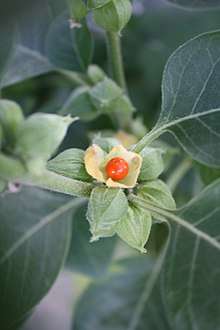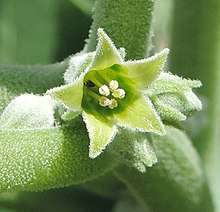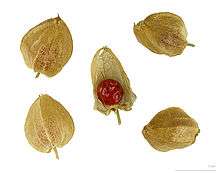Withania somnifera
Withania somnifera, known commonly as ashwagandha,[2] Indian ginseng,[3] poison gooseberry,[3] or winter cherry,[2] is a plant in the Solanaceae or nightshade family. Several other species in the genus Withania are morphologically similar.[4] Although thought to be useful as a medicinal herb in Ayurveda, there is no conclusive clinical evidence that it is effective for treating any ailment.[4][5]
| Withania somnifera | |
|---|---|
 | |
| Scientific classification | |
| Kingdom: | Plantae |
| Clade: | Tracheophytes |
| Clade: | Angiosperms |
| Clade: | Eudicots |
| Clade: | Asterids |
| Order: | Solanales |
| Family: | Solanaceae |
| Genus: | Withania |
| Species: | W. somnifera |
| Binomial name | |
| Withania somnifera | |
| Synonyms[1] | |
| |


Description
This species is a short, tender perennial shrub growing 35–75 cm (14–30 in) tall. Tomentose branches extend radially from a central stem. Leaves are dull green, elliptic, usually up to 10–12 cm (4 to 5 in) long. The flowers are small, green and bell-shaped. The ripe fruit is orange-red.
Etymology
The species name somnifera means "sleep-inducing" in Latin.[6] The name, ashwagandha, is a combination of the Sanskrit words ashva, meaning horse, and gandha, meaning smell, reflecting that the root has a strong horse-like odor.[5]
Cultivation
Withania somnifera is cultivated in many of the drier regions of India. It is also found in Nepal, China[7] and Yemen.[8] It prefers dry stony soil with sun to partial shade. To propagate it can be grown from seed in the early spring, or from greenwood cuttings in the later spring.[9]
Diseases and pests
Withania somnifera is prone to several pests and diseases. Leaf spot disease caused by Alternaria alternata is the most prevalent disease, which occurs in a severe form in Punjab, Haryana, and Himachal Pradesh. A decline in the concentration of its secondary metabolites occurs by leaf spot disease.[10] A treehopper feeds on the apical portions of the stem, making them rough and woody in appearance and brown in colour.
The carmine red spider mite (Tetranychus urticae) is the most prevalent pest of the plant in India.[11] In recent years, this plant has been serving as a new reservoir host for an invasive mealybug species Phenacoccus solenopsis.[12]
Phytochemistry
The main phytochemical constituents are withanolides – which are triterpene lactones – withanolides, withaferin A, alkaloids, steroidal lactones, tropine, and cuscohygrine.[4] Some 40 withanolides, 12 alkaloids, and numerous sitoindosides have been isolated.[4] Withanolides are structurally similar to the ginsenosides of Panax ginseng, leading to a common name for W. somnifera, "Indian ginseng".[4]
Traditional medicine
The plant, particularly its root powder, has been used for centuries in traditional Indian medicine.[4][7] Mainly due to the poor quality of clinical research, there is no high-quality evidence that it provides any medicinal benefit and may cause adverse effects if taken together with prescription drugs.[4][5][13] Dietary supplements containing ashwagandha are marketed in the U.S., but there is no evidence they have any effect.[4]
References
- "Withania somnifera (L.) Dunal". Tropicos. Missouri Botanical Garden. Retrieved 25 Feb 2012.
- "Withania somnifera". Germplasm Resources Information Network (GRIN). Agricultural Research Service (ARS), United States Department of Agriculture (USDA). Retrieved 2011-10-29.
- "Withania somnifera (L.) Dunal". PROTA (Plant Resources of Tropical Africa / Ressources végétales de l’Afrique tropicale) [Online Database]. Wageningen, Netherlands: Gurib-Fakim A. and Schmelzer G. H. Retrieved 2012-08-07.
- "Ashwagandha". Drugs.com. 2009. Retrieved 27 August 2017.
- "Ashwagandha". MedlinePlus, US National Library of Medicine. 26 June 2017. Retrieved 21 December 2017.
- Stearn, W. T. (1995). Botanical Latin: History, Grammar, Syntax, Terminology and Vocabulary (4th ed.). Timber Press. ISBN 978-0-88192-321-6.
- Pandit, S.; Chang, K.-W.; Jeon, J.-G. (February 2013). "Effects of Withania somnifera on the growth and virulence properties of Streptococcus mutans and Streptococcus sobrinus at sub-MIC levels". Anaerobe. 19: 1–8. doi:10.1016/j.anaerobe.2012.10.007. PMID 23142795.
- Hugh Scott & Kenneth Mason, Western Arabia and the Red Sea, Naval Intelligence Division: London 1946, p. 597 ISBN 0-7103-1034-X.
- Deni., Bown (1995). Encyclopedia of herbs & their uses. Montréal: RD Press. ISBN 0888503342. OCLC 32547547.
- Pati, P. K.; Sharma, M.; Salar, R. K.; Sharma, A.; Gupta, A. P.; Singh, B. (2009). "Studies on leaf spot disease of Withania somnifera and its impact on secondary metabolites". Indian Journal of Microbiology. 48 (4): 432–437. doi:10.1007/s12088-008-0053-y. PMC 3476785. PMID 23100743.
- Sharma, A.; Pati, P. K. (2012). "First record of the carmine spider mite, Tetranychus urticae, infesting Withania somnifera in India". Journal of Insect Science. 12 (50): 1–4. doi:10.1673/031.012.5001. PMC 3476950. PMID 22970740.
- Sharma, A.; Pati, P. K. (2013). "First record of Ashwagandha as a new host to the invasive mealybug (Phenacoccus solenopsis Tinsley) in India". Entomological News. 123 (1): 59–62. doi:10.3157/021.123.0114.
- "Ashwagandha". New York City: Memorial Sloan Kettering Cancer Center. 13 April 2018. Retrieved 26 May 2018.
External links
![]()